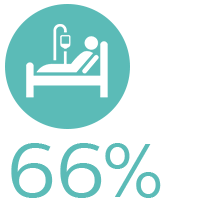Respiratory rate is one of the key early indicators of patient deterioration
Accurate assessment and consistent reporting of respiratory rate is extremely important to detect patient deterioration early. However, manually measuring respiratory rates can be time consuming and overwhelming1. Our solution for early detection of patient deterioration automates both the collection and transmission of respiratory rate measurements, as well as early warning scoring calculations, to help reduce stress and improve workflow for care teams that rely on manual measurement and recording.

Identify patients at risk for deterioration by automating respiratory rate measurement
Just one occurrence of respiratory rate above 27 breaths per minute over a 72-hour period is a predictor of cardiac arrest in hospital wards2 and nearly 440,000 preventable deaths every year in the United States are attributable to failure to rescue by a registered nurse or physician3. Every measurement counts, however it isn’t easy to achieve across a growing and more complex patient population. A recent survey of general care nurses found that many find vitals measurement time consuming and overwhelming and respiratory rate was the only parameter recorded less the 50% of the time4.
The IntelliVue Guardian Solution automatically acquires vital signs, including respiratory rate, calculates an early warning score, displays it at the point of care, and notifies responsible caregivers to intervene quickly.
Education and training are critical
Manual measurement of respiratory rates can present challenges for care providers in detecting patient deterioration:

60% rely on oxygen saturation to evaluate respiratory dysfunction5

57% perceived blood pressure changes as the first indicator of deterioration5

27.4% make quick estimates of the respiratory rate5

Raising awareness of the importance of respiratory monitoring in non-critical care units and making it part of your standard of care can help end preventable deaths.6, 7
Automated early detection makes a significant difference
Deployment of an electronic automated advisory vital signs monitoring and notification system to signal clinical deterioration in ward patients was associated with significant improvements in key patient-centered clinical outcomes.

20% reduction in hospital mortality, including readmissions8

35% reduction of Severe Adverse Events8

66% reduction in ICU mortality of patients transferred to the ICU8

86% reduction of Cardiopulmonary Arrests8
For complete results, view the clinical study:
Automated Early Warning Scoring
Explore all Philips general care solutions

Spot patient deterioration quickly through automated early warning scores and send timely and proper notifications to Rapid Response Teams.

We work with you to identify solutions to help in identifying potential patient deterioration and tailor them to your organization’s needs and goals.
References 1. Mok, W et al. Attitudes towards vital signs monitoring in the detection of clinical deterioration: scale development and survey of ward nurses. Int J Qual Health Care (2015) 27 (3): 207-213. 2. Fieselmann JF, Hendryx MS, Helms CM, et al. Respiratory rate predicts cardiopulmonary arrest for internal medicine patients. J Gen Intern Med 1993; 8: 354-360. 3. HealthGrades, Inc: Third Annual Patient Safety in American Hospitals Study. April 2006 4. Hogan, J. Respiratory assessment. Why don't nurses monitor the respiratory rates of patients? British Journal of Nursing, 15(9) 489–492. 5. Mok, W et al. Attitudes towards vital signs monitoring in the detection of clinical deterioration: scale development and survey of ward nurses. Int J Qual Health Care (2015) 27 (3): 207-213. 6. Christmas, A. el al. Trauma Intensive Care Unit ‘Bouncebacks’: Identifying Risk Factors for Unexpected Return Admission to the Intensive Care Unit. The American Surgeon, Volume 80, Number 8, August 2014, pp. 778-782(5) 7. Schein, RM, el al. Clinical antecedents to in-hospital cardiopulmonary arrest. Chest 1990; 98: 1388-92 8. Subbe, C.P., Duller, B. & Bellomo, R. Crit Care (2017) 21: 52. doi:10.1186/s13054-017-1635-z

